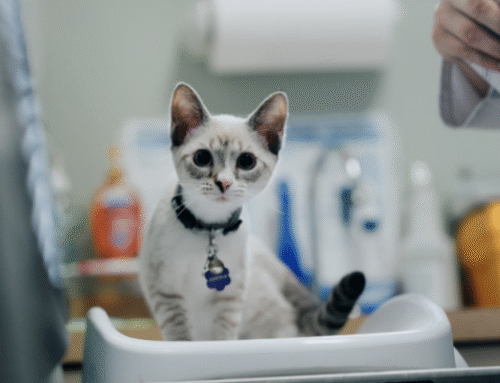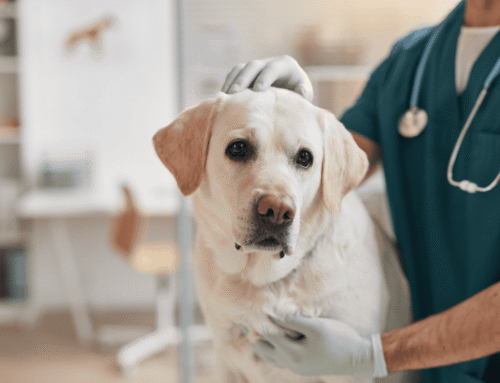Is your furry pal more fat than fluff? If so, they’re not alone. More than half the nation’s pet population is classified as overweight or obese, with 59% of dogs and 61% of cats weighing too much. Since obesity is a growing—pun intended—epidemic among pets, it’s past time to take action to shed extra weight and regain a healthy lifestyle.
Pets who are too heavy are at an increased risk for a multitude of health issues that can not only cause serious problems, but also shorten their life. Some conditions your hefty pet may be more likely to develop include:
- Osteoarthritis
- Skin infections
- Urinary disorders
- Diabetes
- High blood pressure
- Heart disease
- Respiratory issues
- Decreased quality of life
- Some cancers
So many significant medical concerns are more prevalent among overweight pets that learning how to tackle those extra pounds is critical for helping your pet live a longer, healthier life. Our Safe Harbor Animal Hospital team is dedicated to partnering with pet owners in their quest to help their pets reach their ideal weight, so we are sharing key tips on obesity problems and solutions.
Problem: You’re not sure if your pet is truly overweight
Solution: Many pet owners are unaware that their pet is carrying excess weight, especially if their pet is exceptionally furry. By knowing how your pet’s body should look at their ideal weight, you can better judge their current body condition. In general, you should be able to feel your pet’s ribs with minimal pressure, visualize a tucked abdomen when viewed from the side, and see a defined hourglass shape when you look down from above. If these characteristics are not obvious, your four-legged friend is in need of a diet and exercise plan. For help evaluating your pet’s body condition score, schedule an appointment with our team.
Problem: Your pet consumes more calories than they burn
Solution: Eating too much is a key component of obesity in pets, especially if they can access a never-ending buffet. If you use self-feeders or keep their food bowl full, you are allowing your pet to eat as much as they want, whenever they want, which often is excessive. Bored pets in particular will eat when they’re not hungry, so controlling your pet’s calories is essential for healthy weight maintenance.
To ensure your pet eats the appropriate amount according to their body condition, calculate the calories they need each day, and then divide that amount into two or three meals, minus treats. Portion out their meals correctly—no more filling up the food bowl—to help your pet maintain a healthy weight.
Having a supportive partner can increase the likelihood of success. Our team would be happy to help you generate a weight-loss plan for your pet. We can recommend a veterinary diet formulated specifically for weight loss, and let you know exactly how much to feed your pet. We also set small, incremental goals with regular check-ins to help you and your pet stay on track.
Problem: Your pet is a professional couch potato
Solution: Does your four-legged friend seem more a couch potato than the descendent of a fierce hunter? Although domestic cats and dogs have come a long way from their wild ancestors, they require the same amount of activity for their physical and mental health. If your pet doesn’t seem interested in moving from their prime spot on the couch, figure out an activity that they find appealing. Your cat may not be interested in the laser pointer that they can’t physically catch, so try flicking a feather wand or fishing pole toy instead. Your pooch may give you a look that says, “Go fetch your own ball,” when you toss a ball their way, so consider various canine sports that may pique their interest.
Problem: You can’t say “No” when your pet begs for treats
Solution: If your pet has perfected the sad puppy-dog stare when you chow down on a pepperoni pizza or a bag of potato chips, be strong and don’t give in. Many people snacks are high in fat, sugar, and calories, so give your pet healthier alternatives, such as:
- Fresh fruits (e.g., berries, melons, apples)
- Fresh or steamed vegetables (e.g., sweet potatoes, green beans, squash)
- Lean pieces of unseasoned, boneless, skinless meat (e.g., turkey or chicken breast)
- Baby carrots
- Low-fat yogurt or cottage cheese
In addition to fresh-food snacks, you can break treats in half. Dog biscuits can easily be split into small pieces that your pet will happily eat, no matter how small the treat.
Are you unsure if your furry pal is too heavy under all that fluff? Schedule a weight assessment and management plan for your pet with our Safe Harbor Animal Hospital team, and we will help your four-legged friend reach their ideal body condition.









Leave A Comment